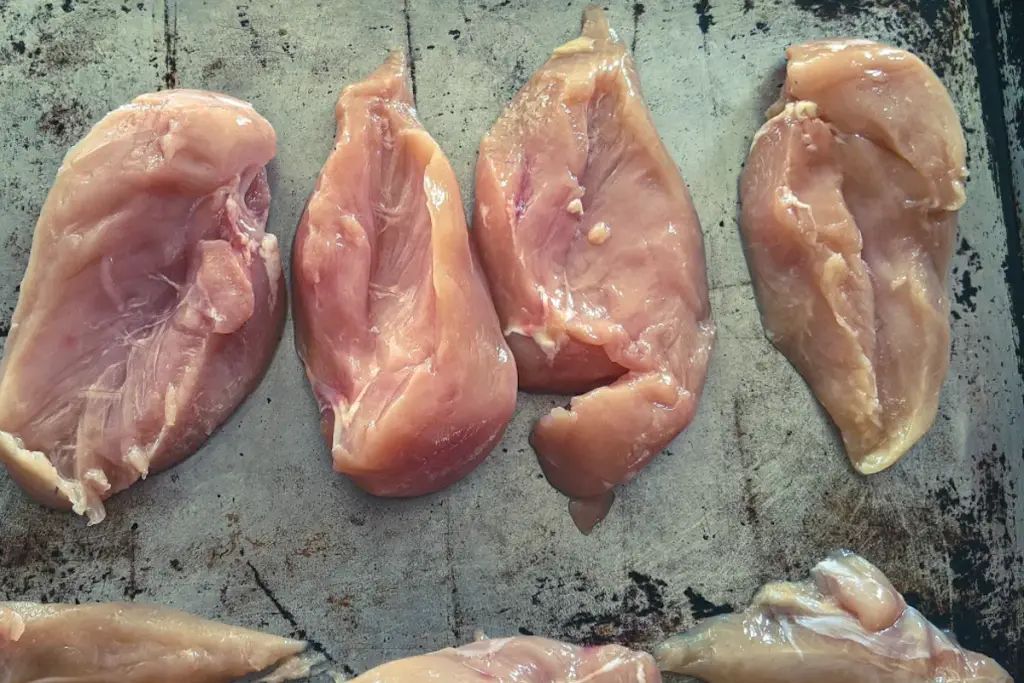Veins In Chicken Breast: Are They Safe To Eat?
Norah Clark
The vein in a chicken breast is more easily spotted than in other parts of the chicken. It is more typical to see veins in chicken that has been simmered on the bones. It is entirely up to you if you want to remove them.
Chicken breast is a protein favorite and a flexible chicken cut.
This cut of meat is is part of a plethora recipes worldwide because of its versatility.
If you’re trying to get the most out of your freshly cooked chicken breasts, read on!
Is It Normal For Chicken Breasts To Have Veins?
If you’re looking at cooked or raw chicken It can be a bit off-putting to notice the red, pink, or even deep purple lines running through the chicken.
After all the years of being warned of the dangers of eating raw or pink poultry meat, should we be concerned when we spot something that appears to be an artery in our chicken breast?
Veins in chicken meat are normal and generally not something to worry about. There are veins in all of us which run through our muscle tissues – this is how our muscle cells get their blood supply!
The muscle’s veins tend to appear near the bone or in between sections of muscle.
When you’re carving the breast of a chicken typically, you’ll find a line about two-thirds the length of the slice of meat, which separates tenderloin from the upper meat of the breast.
The last part of the breast has a tendon that forms an elongated line across the meat. It is not noticeable until it’s cooked as it softens and blends into the meat.
We often don’t notice this vein after the meat has been cooked. It may alter the color of the meat but it’ll have minimal impact on the taste.
Do All Chicken Breasts Have Veins?
Every chicken has this vein, but it is barely noticeable.
Veins found in meat are more common in muscles that are hard-working like the wings and legs. They are not as common in breast meat, yet they still exist.
Most butchers are able to expertly take a chicken breast away from the bone and leave the veins.
Although they could appear unappealing – the veins inside the chicken breast are safe to consume.
Every time we eat meat the muscle tissue is stuffed with tiny veins, which are referred to as capillaries. We’ve been eating them for many years with no issues whatsoever!
The vein we’re all worried about is actually a bigger version of the capillaries.
There is one warning – always ensure the chicken is cooked to perfection.
Pink meat is typically an indication of a chicken that is not cooked properly So you must discover other methods to verify the chicken’s cooked.
If you own a meat thermometer, you can use it to measure the temperature inside the meat. Food safety experts advise that chickens and other types of poultry be cooked to 165°F.
A safe temperature to cook chicken at is 180 degrees F when cooking the whole bird and 165 degrees F for chicken pieces.
Without a meat thermometer, the only way to determine if a chicken is cooked is by observing the hue of the juices that emerge from the meat.
If the juices are clear, then the meat is ready to be eaten. If you notice an orange-red tinge the chicken needs to cook for a bit longer.
How Do You Remove Veins From The Chicken Breast?
The best choice is to buy chicken breasts at the butchery counter, from where they are prepared according to your preferences.
A reliable butcher won’t be averse to removing the veins from the chicken breasts. This will also eliminate the effort of trimming and preparing once home.
If you don’t like having veins appearing in chicken, consider cooking boneless chicken whenever possible. A bone-infested chicken is more likely to have veins than chicken cooked on the bone.

How To Cut The Veins In A Chicken Breast
If you are doing this yourself, follow the steps below:
It may take time to master however, it’s worth it!
- Locate the thicker, more pronounced part of the breast where there is more white tissue. This is the cartilage that connects the breastbone and muscle.
- Make sure you hold the cartilage in a secure position and then put a sharp knife beneath it. It is not easy to cut and you’ll notice some resistance. Cut the cartilage from the meat by pulling it off as you go.
- There may be a piece of gristle that is attached to the cartilage. Cut it off as well. If you attempt this technique the first time, you could be cutting off more of the meat than you might want.
- Below the area where you’ve cut off the cartilage, you could discover a bloody section. This is the area where most of the veins are located and must be removed as well.
- After trimming the chicken breasts, wash them under cold running water, and then lightly dry with a paper towel.
Frequently Asked Questions
What are the red veins in chicken?
Red veins in chicken are blood vessels that have not been completely removed during the butchering process. These veins can be found in both raw and cooked chicken, and they may appear as thin red lines or streaks in the meat.
Is it safe to eat chicken with red veins?
Yes, it is safe to eat chicken with red veins as long as the chicken has been cooked to the appropriate temperature to kill any harmful bacteria. However, some people may find the presence of red veins unappetizing.
Are veins in chicken normal?
Yes, veins in chicken are normal and can be found in both raw and cooked chicken. However, the amount of veins in chicken can vary based on the butchering process.










